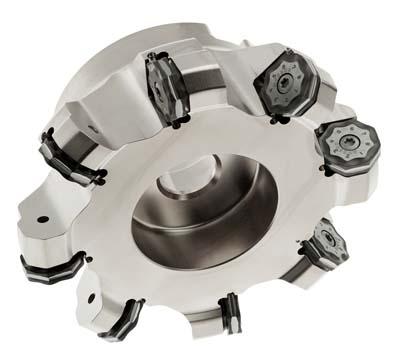
Seco Tools Inc. has introduced its next generation Double Octomill R220.48 facemilling cutter, which offers versatility, economy and productivity in one tool that can be used for roughing and finishing in iron, steel and stainless steel applications. With 16 cutting edges, the Double Octomill reduces edge cost per insert and is a good solution for high metal-removal rates, according to the company. It also offers a positive cutting rake angle no matter what insert style you chose. This allows users to achieve higher cutting speeds for increased productivity and lower component cost. Featuring a design where inserts are positioned in the pockets by hardened HSS pins, the Double Octomill makes indexing precise, easy and secure. The cutter body is prehardened to ensure long cutter body life and has a hard nickel coating that protects it from wear and prevents chips from welding. The Double Octomill is offered in normal, normal+ and close pitch in metric sizes and in normal and close pitch in inch. Thick and robust direct-pressed inserts offer high strength and low risk of edge breakage to provide high performance. The insert edges are numbered. Using the same number in every pocket helps reduce runout. It is available in five different geometries including wiper inserts.
Contact Details
Related Glossary Terms
- facemilling
facemilling
Form of milling that produces a flat surface generally at right angles to the rotating axis of a cutter having teeth or inserts both on its periphery and on its end face.
- high-speed steels ( HSS)
high-speed steels ( HSS)
Available in two major types: tungsten high-speed steels (designated by letter T having tungsten as the principal alloying element) and molybdenum high-speed steels (designated by letter M having molybdenum as the principal alloying element). The type T high-speed steels containing cobalt have higher wear resistance and greater red (hot) hardness, withstanding cutting temperature up to 1,100º F (590º C). The type T steels are used to fabricate metalcutting tools (milling cutters, drills, reamers and taps), woodworking tools, various types of punches and dies, ball and roller bearings. The type M steels are used for cutting tools and various types of dies.
- pitch
pitch
1. On a saw blade, the number of teeth per inch. 2. In threading, the number of threads per inch.
- rake
rake
Angle of inclination between the face of the cutting tool and the workpiece. If the face of the tool lies in a plane through the axis of the workpiece, the tool is said to have a neutral, or zero, rake. If the inclination of the tool face makes the cutting edge more acute than when the rake angle is zero, the rake is positive. If the inclination of the tool face makes the cutting edge less acute or more blunt than when the rake angle is zero, the rake is negative.
- wiper
wiper
Metal-removing edge on the face of a cutter that travels in a plane perpendicular to the axis. It is the edge that sweeps the machined surface. The flat should be as wide as the feed per revolution of the cutter. This allows any given insert to wipe the entire workpiece surface and impart a fine surface finish at a high feed rate.

